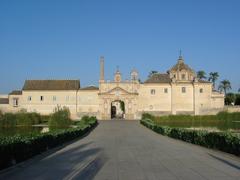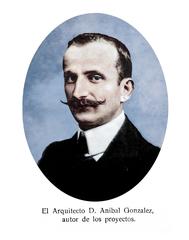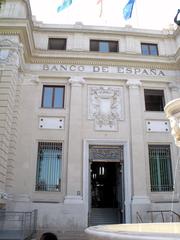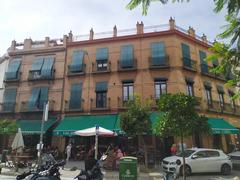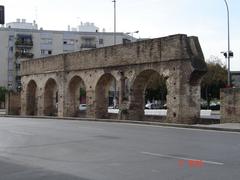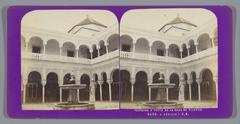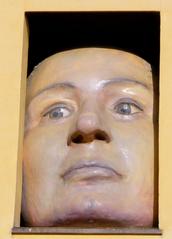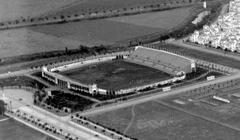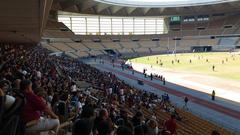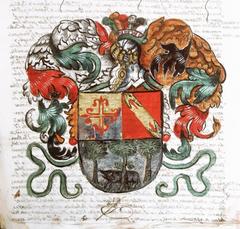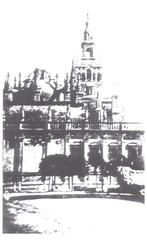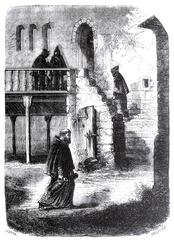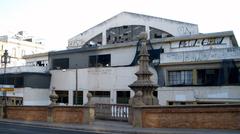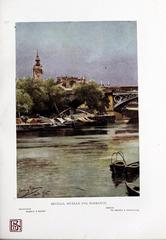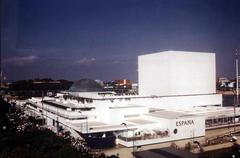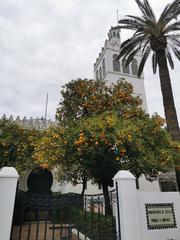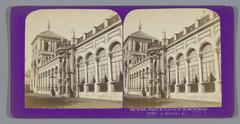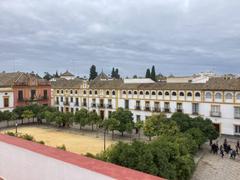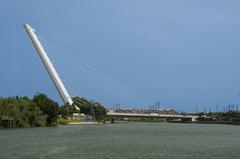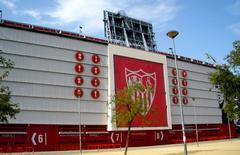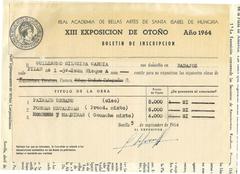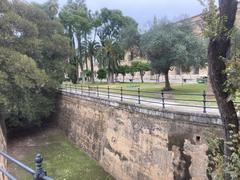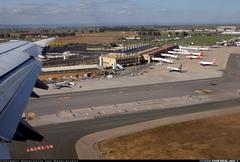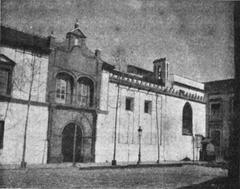Hotel Triana Seville: Visiting Hours, Tickets, and Historical Significance
Date: 14/06/2025
Introduction to Hotel Triana Seville
Nestled on the western bank of the Guadalquivir River, Hotel Triana places visitors in the heart of one of Seville’s most vibrant and historically significant neighborhoods. Triana’s roots trace back to Roman times, its name potentially honoring Emperor Trajan or referencing “triple crossing,” indicative of its strategic riverside location. Historically, Triana thrived as an independent settlement renowned for its maritime commerce, robust crafts, and distinctive working-class identity (TravelMag; España Guide).
Triana is celebrated as a cradle of Andalusian culture, particularly flamenco. The neighborhood’s Romani community, alongside Moorish, Jewish, and local influences, helped forge this passionate art form (Miss Tourist; Carrots and Tigers). Its artisanal legacy, especially in ceramics, thrives in landmarks like the Centro Cerámica Triana and historic workshops (TravelMag; Spanish Sabores).
Staying at Hotel Triana provides easy access to iconic sites such as the Puente de Isabel II (Triana Bridge), a 19th-century architectural symbol uniting Triana with Seville’s historic core, and offers a panoramic gateway to the district’s rich blend of tradition and modernity (TravelMag; Introducing Seville).
This guide presents an in-depth exploration of Triana’s historical development, practical visitor information—including opening hours and tickets for key sites—accommodation recommendations, cultural highlights, and essential travel tips. Whether you wish to discover Seville’s historical attractions, enjoy authentic flamenco, or savor Triana’s culinary scene, this article will help you plan an enriching visit (Seville City Guide; Roam and Thrive; Visitar Sevilla).
Contents
- Origins and Early Development of Triana
- Triana’s Role in Seville’s Urban and Social Fabric
- Flamenco and Artistic Heritage
- Religious and Architectural Landmarks
- The Spanish Inquisition and Castillo de San Jorge
- Triana’s Modern Identity
- Practical Visitor Information
- Visiting Hours & Tickets
- Getting There
- Events and Photo Spots
- Accommodation Guide: Hotels in Triana
- The Triana Bridge: History and Visiting Tips
- Triana’s Culture: Flamenco, Ceramics, and Gastronomy
- Festivals and Local Events
- Practical Tips
- Key Sights Near Hotel Triana
- Accessibility
- Visuals and Media Recommendations
- Frequently Asked Questions (FAQ)
Exploring Triana: History, Sights, and Visitor Information
Origins and Early Development
Triana’s history predates its integration with Seville, flourishing as a strategic settlement due to its riverside location. Its name may link to Roman Emperor Trajan or the Latin “Tri-ana” (triple crossing), pointing to its commercial importance (TravelMag). During Moorish rule, Triana’s ceramics industry emerged—thanks to local clay—resulting in the azulejos tiles still visible throughout the city (Seville City Guide).
Urban and Social Fabric
Triana became a hub for maritime trade, initially joined to Seville by a pontoon bridge, later replaced by the 19th-century Puente de Isabel II. The community developed a strong local identity, with many residents—trianeros—expressing distinct pride in their heritage (Spanish Sabores).
Flamenco and Artistic Heritage
Triana’s Romani and multicultural influences made it a birthplace of flamenco. Visitors today can experience live flamenco in intimate venues and explore the district’s ceramics tradition at workshops and the Centro Cerámica Triana (Miss Tourist; Spanish Sabores; TravelMag).
Religious and Architectural Landmarks
Key landmarks include the Parroquia de Santa Ana (1276), the oldest church in Seville and a prime Gothic-Mudéjar example (Seville City Guide). The Capilla de los Marineros houses the revered Virgin Esperanza de Triana statue, central to Seville’s Semana Santa processions (Spanish Sabores).
The Spanish Inquisition and Castillo de San Jorge
The Castillo de San Jorge, a Moorish fortress, served as the Spanish Inquisition’s headquarters from 1481 to 1785 (TravelMag). Today, its remains beneath the Mercado de Triana host a museum detailing this turbulent period.
Triana’s Modern Identity
Modern Triana combines tradition and contemporary life. Its streets are lined with tapas bars, flamenco venues, artisan shops, and the vibrant Mercado de Triana (Spanish Sabores; Seville City Guide). Calle Betis, the riverside promenade, is a scenic spot for evening walks and dining (TravelMag).
Practical Visitor Information
Visiting Hours & Tickets
- Centro Cerámica Triana: Tuesday–Sunday, 10:00 AM–6:00 PM. Adult tickets: ~€5. Guided tours available; book ahead in peak season.
- Parroquia de Santa Ana: Open most days; check local schedules for specifics.
- Museo del Castillo de San Jorge: Tuesday–Sunday, 10:00 AM–5:30 PM. Tickets: ~€4.
Getting There
Triana is a short walk from central Seville via the Puente de Isabel II, offering excellent city views (Spanish Sabores). Buses and taxis are also convenient options.
Events and Photo Spots
- Semana Santa: Processions featuring Esperanza de Triana.
- Calle Betis & Bridge: Ideal for cityscape photography.
Accommodation Guide: Hotels in Triana
Distinctive Heritage and Hospitality
Triana’s hotels reflect its cultural legacy, blending Andalusian design with modern amenities (España Guide; Roam and Thrive). Many feature traditional elements like azulejos and wrought ironwork.
Location and Attractions
Hotels offer proximity to Seville’s major sites—Cathedral, Giralda, Royal Alcázar—and riverfront views. Examples include Hotel Ribera de Triana, Zenit Sevilla, and Triana House.
Accommodation Options
- Hotel Ribera de Triana: Luxury, river views, rooftop terrace.
- Zenit Sevilla: Modern with Andalusian touches, on-site dining.
- Triana House: Boutique guesthouse focused on sustainability (Breathing Travel; New Hotels Guide).
Integrating Local Culture
Many hotels feature local art, flamenco performances, and collaborations with artisans. The Mercado de Triana and Calle Betis are steps away, offering authentic experiences (España Guide).
Booking and Tips
- Reserve early, especially in June and during festivals (Tour Travel & More).
- Many hotels offer accessible rooms; confirm directly.
The Triana Bridge: History and Visiting Tips
Overview
The Puente de Isabel II (Triana Bridge) is a 19th-century iron bridge connecting Triana to Seville’s historic center. Open 24/7 to pedestrians and vehicles, it offers panoramic river and skyline views (TravelMag).
Accessibility and Tours
Wheelchair-accessible with ramps; walking and cycling are permitted. Free access, but guided walking tours are available for deeper historical context.
Nearby Attractions
- Mercado de Triana
- Maestranza Bullring
- Ceramics Museum
- River Cruises
Triana’s Culture: Flamenco, Ceramics, and Gastronomy
Flamenco
Triana is the birthplace of flamenco, hosting renowned tablaos such as Triana Flamenco Theatre and Baraka Tablao Flamenco. Tickets range from €15–€30, available online or at the venue (Visitar Sevilla; Andalucia Mia).
Ceramics
Triana’s ceramics tradition is visible in workshops along Calle San Jorge and Calle Alfarería. Centro Cerámica Triana is open Tuesday–Saturday, 10 AM–2 PM & 5 PM–8 PM; Sunday, 10 AM–2 PM (Carrots and Tigers; Introducing Seville).
Markets and Food
- Mercado de Triana: Monday–Saturday, 8 AM–3 PM (Visit Southern Spain).
- Mercado Lonja del Barranco: Noon–1 AM (food until 10 PM).
Festivals and Local Events
- Velá de Santa Ana: Late July celebration of music and dance.
- Circada Festival: Contemporary circus event in June (Visit Southern Spain).
Practical Tips
- Accommodation: Book early for festivals (Mundo Maya Travel Guide).
- Getting Around: Walkable; buses and bikes available.
- Safety: Watch for pickpockets in crowded areas.
- Etiquette: Greet shopkeepers; tipping is appreciated but optional.
- Language: Basic Spanish helps; English tours widely available (Andalucia Mia).
- Dining: Seek out local-frequented tapas bars for the best experience.
- Shopping: Unique ceramics and crafts make memorable souvenirs (Carrots and Tigers).
Key Sights Near Hotel Triana
- Triana Bridge (Puente de Isabel II): Gateway to the city (Introducing Seville).
- Plaza del Altozano: Triana’s lively main square (Visitar Sevilla).
- Calle Betis: Vibrant riverside nightlife.
- Corrales: Traditional communal courtyards (Visitar Sevilla).
- Boat Rides: Depart from Triana for scenic city views (Visitar Sevilla).
Accessibility
Triana’s flat terrain is generally accessible, though some historic streets may be uneven. Modern hotels and public spaces offer ramps and elevators (Mundo Maya Travel Guide).
Visuals and Media Recommendations
Consider using interactive maps, virtual tours of flamenco venues, and photo galleries of key sites with descriptive alt text such as “Triana visiting hours” or “Triana tickets” for enhanced planning and accessibility.
Frequently Asked Questions (FAQ)
Q: What are Triana’s visiting hours?
A: Most sites open Tuesday–Sunday, 10 AM–6 PM. Markets run 8 AM–3 PM, Monday–Saturday.
Q: How do I buy tickets for Triana sites or flamenco shows?
A: Online via official websites or at the venue. Guided tours should be booked in advance.
Q: Is Triana accessible for wheelchair users?
A: Many modern sites are accessible, but some historic areas may pose challenges. Check with venues ahead.
Q: Are there English-language guided tours?
A: Yes, several companies offer English tours focused on flamenco, ceramics, and local history.
Summary: Key Points & Final Tips
Triana embodies Seville’s vibrant character through its historical layers, enduring crafts, and dynamic cultural life. Staying at Hotel Triana offers direct access to major landmarks, including Parroquia de Santa Ana, Castillo de San Jorge, and the Triana Bridge, while immersing visitors in authentic Andalusian experiences—from lively markets and tapas bars to world-class flamenco (TravelMag; Spanish Sabores; Roam and Thrive).
With clear guidance on visiting hours, ticketing, accessibility, and local insights, this guide ensures a seamless visit. Choose from a range of accommodations blending local tradition and comfort, take advantage of interactive resources, and engage deeply with Triana’s living heritage (Seville City Guide; Mundo Maya Travel Guide).
For a truly memorable Andalusian adventure, use this guide in combination with the Audiala app, interactive maps, and virtual tours. Embrace Triana’s welcoming community, savor its flavors, and experience its artistic spirit.
References and Further Reading
- TravelMag: Exploring Triana – Visiting Hours, Tickets, and Historical Sites in Seville
- Roam and Thrive: Triana Hotels in Seville – Your Guide to Authentic Stays Near Historic Sites
- Carrots and Tigers: Visiting Triana, Seville – Cultural Heritage, Flamenco, and Practical Tips
- Seville City Guide
- Spanish Sabores: Triana Neighborhood Seville
- Miss Tourist: Where to Stay in Seville Spain – Best Hotels
- Introducing Seville
- España Guide: Triana Seville
- Visitar Sevilla: Triana Seville
- Mundo Maya Travel Guide: Seville Travel Guide
- Visit Southern Spain: Seville in June
- Tour Travel & More: What to Do in June in Seville
